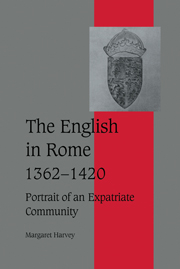Book contents
- Frontmatter
- Contents
- Acknowledgements
- List of abbreviations
- Maps
- Introduction
- 1 The setting I: Rome in the later fourteenth century, 1362–1376
- 2 The setting II: Rome, 1376–1420
- 3 S Thomas's hospice
- 4 S Chrysogonus' hospice and other enterprises
- 5 The laity in Rome
- 6 Women
- 7 The English in the curia 1378–1420: I
- 8 The English in the curia 1378–1420: II
- 9 The career of John Fraunceys
- 10 Adam Easton, an English cardinal: his career
- 11 Adam Easton's ideas and their sources
- 12 Conclusion
- Bibliography
- Index
- Cambridge Studies in Medieval Life and Thought Fourth Series
9 - The career of John Fraunceys
Published online by Cambridge University Press: 28 July 2009
- Frontmatter
- Contents
- Acknowledgements
- List of abbreviations
- Maps
- Introduction
- 1 The setting I: Rome in the later fourteenth century, 1362–1376
- 2 The setting II: Rome, 1376–1420
- 3 S Thomas's hospice
- 4 S Chrysogonus' hospice and other enterprises
- 5 The laity in Rome
- 6 Women
- 7 The English in the curia 1378–1420: I
- 8 The English in the curia 1378–1420: II
- 9 The career of John Fraunceys
- 10 Adam Easton, an English cardinal: his career
- 11 Adam Easton's ideas and their sources
- 12 Conclusion
- Bibliography
- Index
- Cambridge Studies in Medieval Life and Thought Fourth Series
Summary
The career of John Fraunceys illustrates the problems of a curialis without sufficient backing from England. It also reveals in detail the working of the curia and how members used it. The role of proctors and the interactions of the members of the English group stand out too. It is rare to be able to investigate so fully a career spent largely in Rome with no personal papers to use; the good fortune that the deeds for his properties remain in the English College and that one of his cases involved William Swan means that a great deal can be reconstructed.
When Fraunceys first comes to notice he was enjoying royal patronage. The king presented him in May 1379 to Wolvesnewton church, Monmouth, in Llandaff diocese. In February 1380 he became vicar of Aston Colvyle, in Coventry and Lichfield diocese, probably Aston in modern Birmingham, in the king's hands because of the confiscation of alien priories. In May 1380 he was presented to the church of S Mary Moysi, in London, vacant for the same reason. In 1381, called now king's clerk, he was exchanging this for the free chapel of Spargove, Somerset, in the diocese of Bath and Wells. In 1384 the king ordered him to be given maintenance in the hospital of S Leonard, York.
All this prefaced a curial career. By April 1388 he had gone to Rome, where in November he was appointed abbreviator at the request of King Richard, whose clerk he was.
- Type
- Chapter
- Information
- The English in Rome, 1362–1420Portrait of an Expatriate Community, pp. 174 - 187Publisher: Cambridge University PressPrint publication year: 2000



